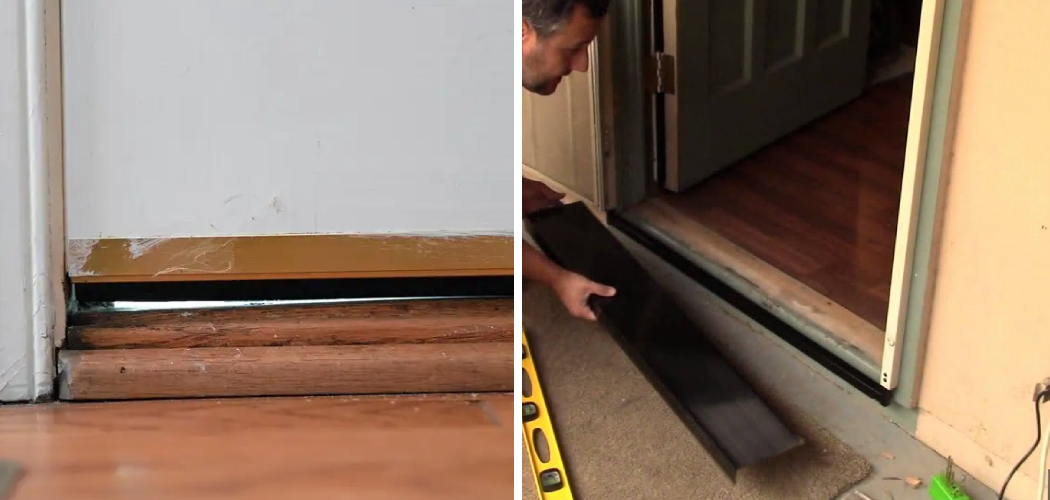Sealing the gap under an exterior door threshold is a crucial task to ensure both energy efficiency and protection against the elements. A gap beneath the threshold can allow cold drafts, water, pests, and debris to infiltrate your home, leading to discomfort and potential damage.
Whether you’re aiming to enhance insulation, keep your interior spaces clean and dry, or prevent unwelcome guests from entering, addressing this gap is a practical home improvement endeavor. This guide is designed to walk you through the process of how to fill gap under exterior door threshold.
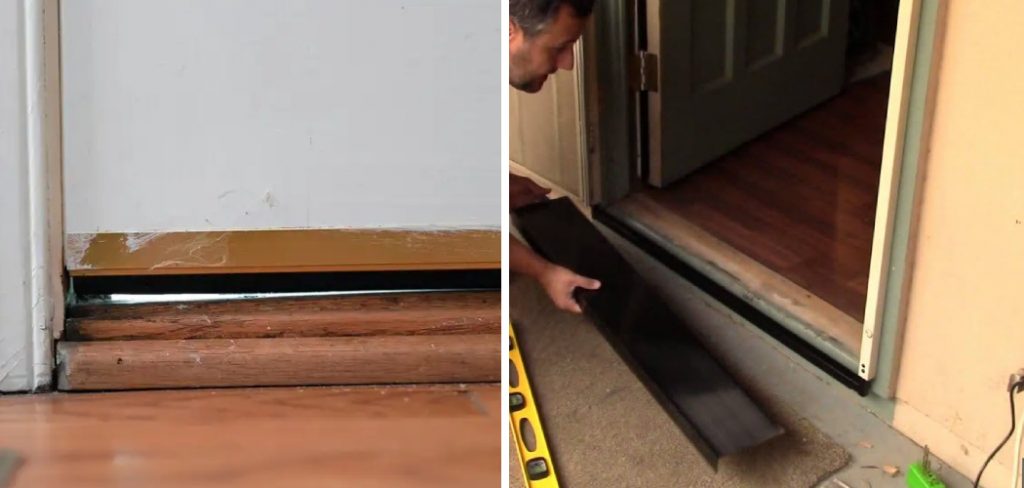
From identifying the underlying causes of the gap to selecting the appropriate materials and techniques for sealing it, you’ll discover the steps needed to create a secure barrier against external factors. Say goodbye to energy wastage and maintenance woes as you embark on this project, safeguarding your home with a renewed sense of comfort and protection.
The Importance of Addressing Gaps under Exterior Door Thresholds
The presence of gaps under exterior door thresholds can pose a serious problem. These openings create an easy point of entry for weather, insects, and other pests. They can also cause drafts that make your home less energy efficient. If not addressed in a timely manner, the resulting damage can be expensive to repair. That’s why it’s essential to seal any gaps you find beneath exterior door thresholds.
Fortunately, filling the gap is a relatively straightforward task that anybody can do with minimal effort. All it takes is some basic materials and tools, along with an understanding of the steps involved. With this in hand, let’s look at how to fill the gap under an exterior door threshold.
Start by inspecting the threshold for any signs of damage. If you find any, repair it before proceeding. Once this is done, measure the width and depth of the gap to figure out how much material you’ll need. Next, purchase a sealant that’s designed for outdoor use.
Now it’s time to start filling the gap. Apply a generous amount of sealant to a caulking gun. Then, starting from the middle of the gap, slowly squeeze the trigger while moving the gun along the length of the threshold. Once you’ve filled in all areas, smooth out any excess material with a putty knife or other similar tool.
The Need to Assess the Size and Nature of the Gap Before Proceeding
When looking to fill a gap under an exterior door threshold, assessing the size and nature of the gap is essential. If it is too large for caulking, then you will need to look at other options. The shape of the gap may also influence your decision on what type of material to use. It’s important to make sure that whatever product you choose is designed to be used outdoors and has the durability to withstand weather.
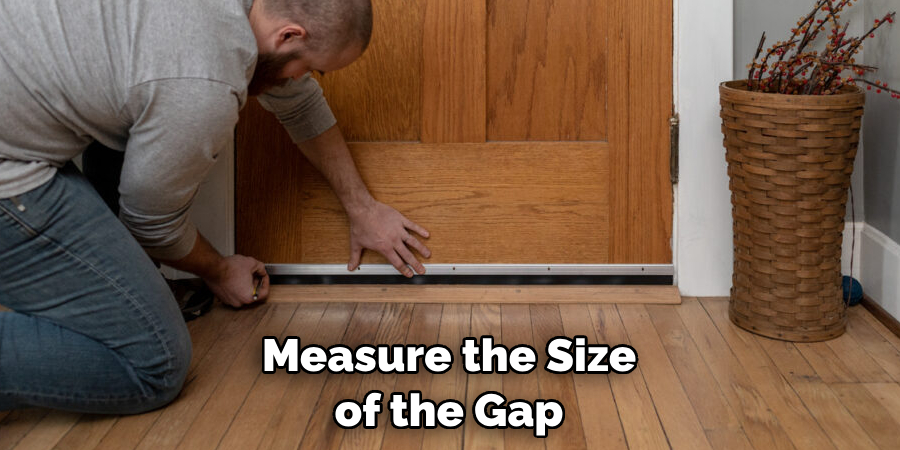
If you find that the gap is too large for regular caulk, then one of the best products you can use is a caulking strip. This type of product is flexible and comes in a variety of sizes, so it should fit most any size gap under an exterior door threshold. The great thing about it is that it can be cut to fit your needs. All you have to do is remove the backing and press the strip into place.
If the gap in an exterior door threshold is particularly wide, then a product like a backer rod may be necessary. This type of fill material gives the caulk something to adhere to and provides additional support. It is important to measure the width of the gap before purchasing any type of filler material.
If you’re unsure about what type of product to use, it is always best to talk with a professional. A contractor or home improvement specialist can help provide advice and guidance on how best to fill any gaps under an exterior door threshold. By taking the time to assess the size and nature of the gap, you can ensure that you select the best product for your needs.
10 Steps on How to Fill Gap Under Exterior Door Threshold
1. Measure the Gap
The first step in filling a gap under an exterior door threshold is to measure the size of the gap. This will help you determine how much material you need to purchase for the job. You should measure both the width and depth of the gap with a tape measure.
2. Clean Out Any Debris
Once you have measured the gap, it’s time to clean out any debris that may be present in the area. Use a vacuum or broom to remove any dust, dirt, or other debris from the space. Be sure to get into all of the crevices and corners of the gap so that there is nothing left behind that could interfere with your repair job.
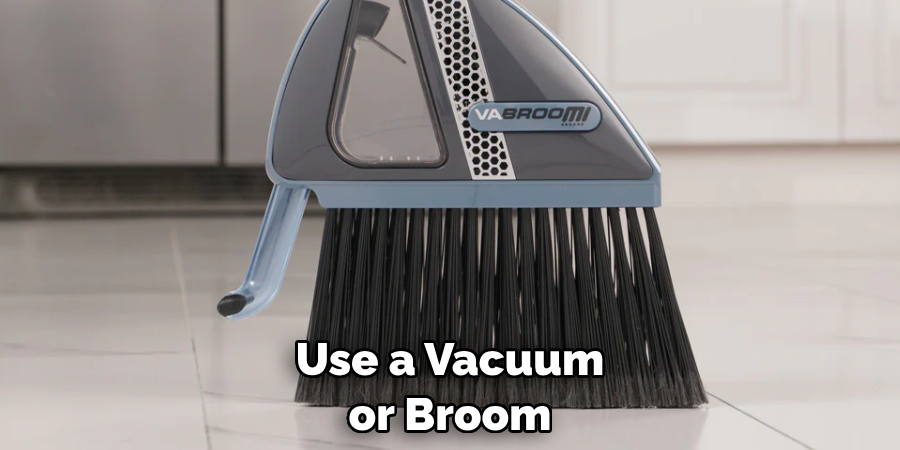
3. Choose Your Filler Material
Next, you will need to choose what type of material you want to use as a filler for your gap. There are several different options available, including foam insulation strips, expanding foam sealant, caulk, and weatherstripping tape. Consider which option would be best suited for your particular application before making your purchase.
4. Cut The Filler To Size
Once you have chosen your filler material, it’s time to cut it down to size so that it fits perfectly in your gap under the door threshold. If you are using foam insulation strips or weatherstripping tape, use scissors or a utility knife to trim them down until they fit snugly in place without leaving any excess material behind.
5. Apply Adhesive
If necessary, apply adhesive onto one side of your chosen filler material before placing it into position in your gap under the door threshold. Most types of foam insulation strips and weatherstripping tapes come pre-coated with adhesive on one side already; however, some may require additional adhesive if needed for extra security and stability when installed in place beneath your exterior door threshold.
6. Place The Filler Into Position
Once your adhesive has had enough time to set (if applicable), carefully place your chosen filler material into position underneath your exterior door threshold until it fits snugly into place without leaving any gaps or spaces between itself and the surrounding surface area around it on either side of its edges or corners once installed correctly in position beneath your door threshold area itself.
7. Secure The Filler In Place
Securely fasten down any loose ends or edges of your chosen filler material into place underneath your exterior door threshold using nails or screws as appropriate for added stability and security once installed correctly beneath this specific area itself..
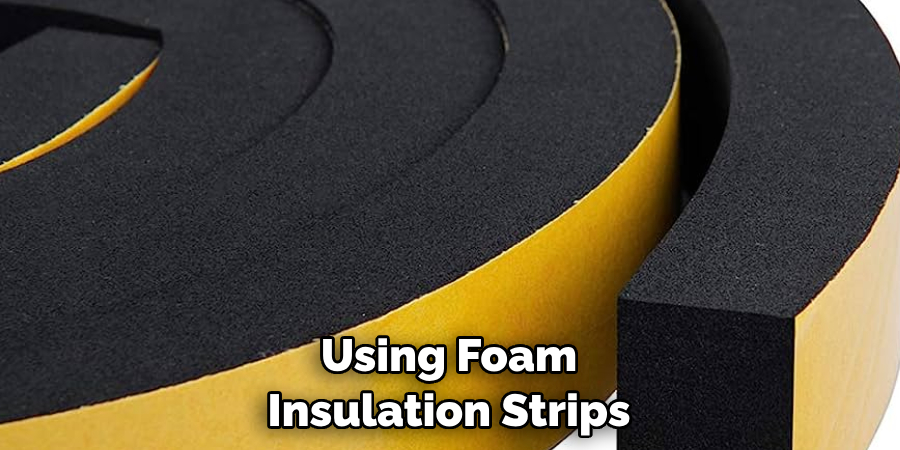
8. Trim Excess Material Away
Once everything is securely fastened down into place underneath your exterior door threshold as needed, use a utility knife or scissors (as applicable)to trim away any excess pieces or sections of filler material that may be sticking out beyond its intended placement area beneath this specific area itself.
9. Seal Around The Edges
Finally, use a quality sealant product such as silicone caulk around all four sides (top, bottom, left & right)of where each piece of chosen filler material has been placed into position underneath this specific area itself.. This will help ensure that no moisture can penetrate through these areas and cause damage over time if not taken care of now while performing this task itself.
10. Test For Air Leaks
Once everything has been completed, test each section where each piece of chosen filler material has been placed underneath this specific area itself by feeling around with both hands for air leaks which may still exist even after following all steps listed above correctly.
If any air leaks are found, then take necessary steps immediately by either adding more sealant product around these areas as needed OR replacing entire section(s)of chosen filler material until no more air leaks can be found within these areas themselves.
The Benefits of Effectively Sealing Gaps under Exterior Door Thresholds
Exterior doors, such as those leading to a patio or backyard area, are vulnerable to gaps and crevices that can affect energy efficiency. Sealing any gap under the door threshold is important for keeping your home insulated and protecting it from weather damage. Here are three ways in which effectively sealing these gaps can benefit you:
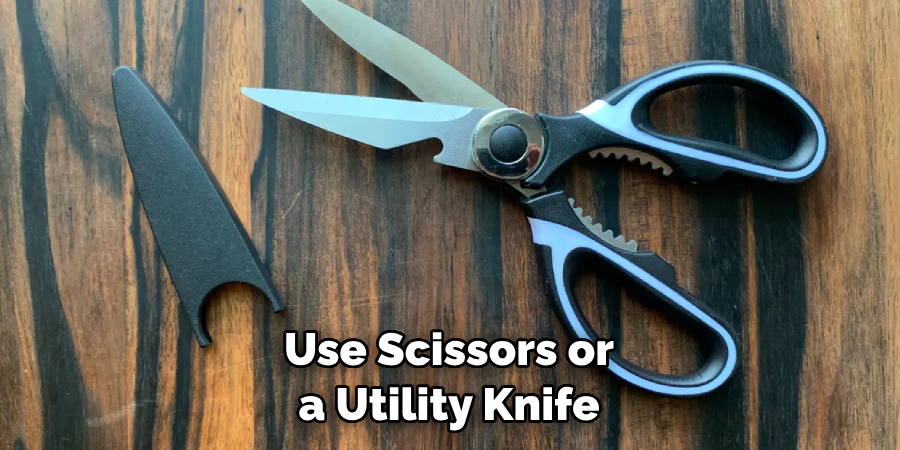
- Improved Security – Sealing gaps under the door threshold helps to protect your home from potential intruders. Unsealed thresholds can provide easy access for burglars, but sealing them greatly reduces this risk.
- Enhanced Energy Efficiency – Filling these gaps will help keep cold air out and warm air in during the winter months, reducing your energy costs. In addition, by keeping outdoor air out, you can also improve the quality of your indoor air.
- Reduced Noise – Sealing these gaps will not only keep the weather and pests outside but also reduce the amount of noise that travels through your door threshold. This is especially beneficial if you live in a noisy neighborhood or near a busy street.
The steps for filling gaps under an exterior door threshold vary based on the type of material used. Most thresholds are made of wood, aluminum, or vinyl; however, all require the use of a sealant to effectively fill and seal these gaps. You’ll also need a putty knife and some form of insulation in order to complete this task.
Things to Consider When Filling Gaps Under Exterior Door Thresholds
While the task of filling gaps under exterior door thresholds may seem straightforward, there are actually a few crucial factors to consider before starting.
The first is proper insulation. When looking to fill any gap between the door and threshold, it’s important to use an insulation material that will not expand or contract in response to varying temperatures and humidity levels. This will ensure that the seal remains airtight. Additionally, it’s important to use an insulation material that has a long lifespan and is impervious to mold and pests.
The second factor to consider is proper weatherproofing. In order to keep moisture out of the home, any gaps between the door and threshold must be properly sealed with a waterproof sealant or caulk. This will help protect the interior of the home from any potential water damage and further improve insulation.
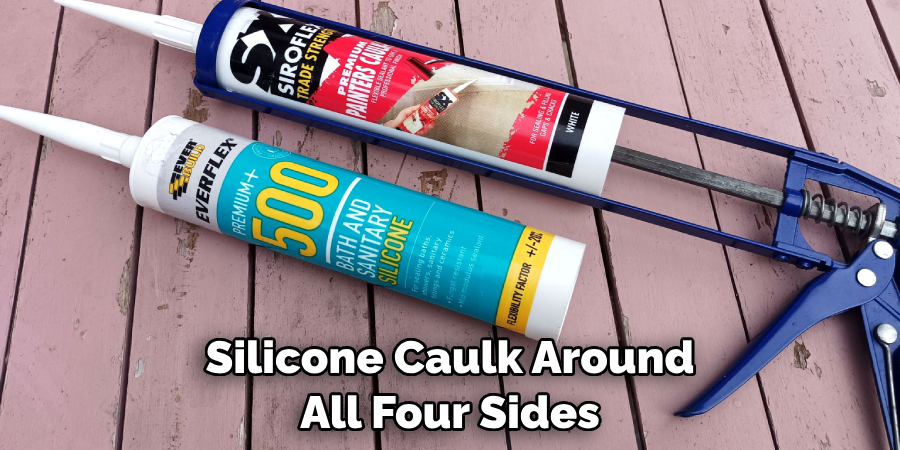
Finally, it’s important to consider the type of threshold being used. Generally speaking, wooden thresholds are better suited for use with traditional doorways while metal thresholds are better suited for modern doorsets.
Some Common Mistakes When Filling Gaps Under Exterior Door Thresholds
When first tackling the task of filling a gap under an exterior door threshold, it is important to be aware of some common mistakes that can occur.
One mistake you should avoid is using the wrong type of caulk for the job. For instance, silicone caulk might seem like a good choice since it’s waterproof and flexible, but when used outdoors, it tends to crack, discolor, and need frequent replacement. A better option is an elastomeric caulk, which is designed for outdoor use and will remain flexible even after it dries.
Another mistake to avoid is overfilling the gap with caulk. Too much can cause a buildup that won’t last and may end up leaving you with an uneven surface. Instead, aim to fill the gap enough so that the caulk is level with the top of the threshold.
Be sure to also leave a small space between the caulk and the door frame. This allows for more flexibility and ensures that the two pieces don’t stick together when they expand and contract under different temperatures.
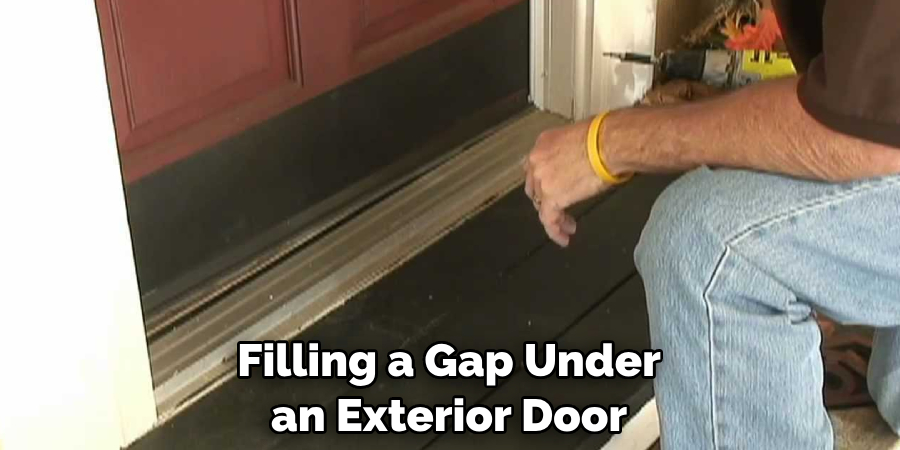
Conclusion
In conclusion, it is important to remember that there are many ways you can fix the gap under an exterior door threshold. You may choose to seal off the gap with caulk, attach a draft stopper, or pull out the entire threshold and reinstall it. Each of these three solutions is easy to implement but it’s important to ensure that none of them will cause further damage to your home.
Ultimately, the best option for each individual homeowner depends on their specific circumstances and desired results. Utilizing one of these methods should help you keep your home warm and save on energy costs in the long run. So if you have been wondering how to fill gap under exterior door threshold – give one of these solutions a try today!
